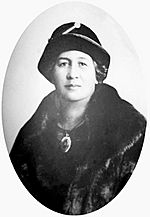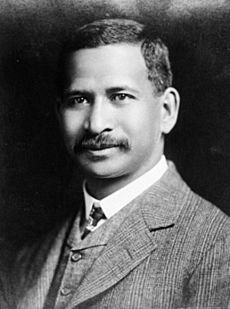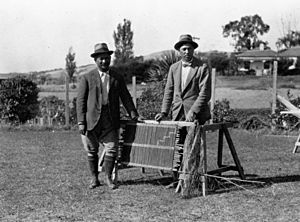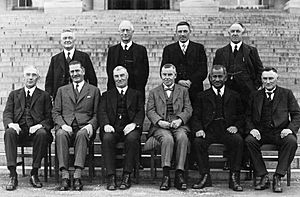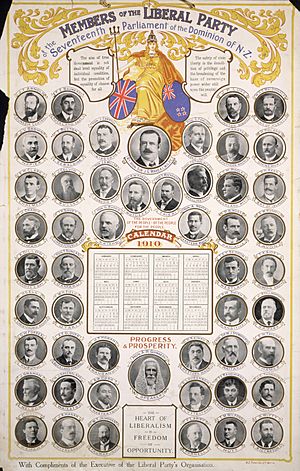Āpirana Ngata facts for kids
Quick facts for kids
Sir Āpirana Ngata
|
|
|---|---|
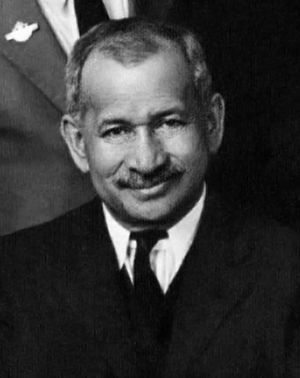
Āpirana Ngata in 1934
|
|
| 22nd Minister of Native Affairs | |
| In office 10 December 1928 – 1 November 1934 |
|
| Prime Minister | Sir Joseph Ward George Forbes |
| Preceded by | Gordon Coates |
| Succeeded by | George Forbes |
| Father of the Parliament | |
| In office 18 November 1929 – 30 August 1943 |
|
| Preceded by | Thomas Wilford |
| Succeeded by | Peter Fraser |
| Member of the New Zealand Parliament for Eastern Maori |
|
| In office 20 December 1905 – 25 September 1943 |
|
| Preceded by | Wi Pere |
| Succeeded by | Tiaki Omana |
| Personal details | |
| Born | 3 July 1874 Te Araroa, Gisborne, New Zealand |
| Died | 14 July 1950 (aged 76) Waiomatatini, New Zealand |
| Political party | Liberal United National |
| Spouse |
Arihia Kane Tamati
(m. 1895; died 1929) |
| Relatives | Sir Hēnare Ngata (son) |
Sir Āpirana Turupa Ngata (born 3 July 1874 – died 14 July 1950) was a very important New Zealand leader. Many people say he was the most important Māori politician in the parliament during the mid-1900s. He is also famous for helping to keep Māori culture and language strong.
Sir Āpirana Ngata's work is remembered as one of the most significant of any New Zealand leader in the 20th century. You can even see his picture on the New Zealand $50 banknote.
Before he became a politician, Ngata worked as a lawyer. In 1897, he helped start the Young Māori Party. This group included other young Māori leaders who had studied at Te Aute College. Ngata wanted Māori people to try new ways of living. He encouraged them to use science and modern health practices, like Pākehā (European New Zealanders), instead of some old traditions. This made him a bit controversial at the time.
In 1905, he was elected as a Member of Parliament (MP) for the Eastern Maori area, representing the Liberal Party. He held this seat for almost 40 years. From 1928 to 1934, he was the Minister of Native Affairs, working hard to bring many changes for Māori. He had to leave this role because of some issues with how money was managed. However, he stayed an MP until 1943. He was then replaced by Tiaki Omana, a candidate from the Rātana movement, which was linked to the Labour Party.
When he was 69, Sir Āpirana Ngata went back to his home in Ngāti Porou, near Gisborne. He lived there with his four sons, four daughters, and many grandchildren until he passed away seven years later.
Contents
Growing Up: Early Life and Education
Ngata was born in Te Araroa, a small town on the coast. It was then called Kawakawa. This town is about 175 kilometres (109 miles) north of Gisborne, New Zealand. He belonged to the Ngāti Porou tribe.
His father, Paratene Ngata, was a tribal leader who knew a lot about traditional Māori stories and customs. His mother, Katerina Naki, was the daughter of a Scottish man. Ngata learned a lot from his father and his great-uncle, Ropata Wahawaha. Ropata Wahawaha had led Ngāti Porou fighters against enemies in the East Cape War.
Ngata grew up speaking the Māori language and living in a Māori way. But his father also made sure he learned about the Pākehā world. His father believed this knowledge would help the Ngāti Porou tribe.
Ngata went to primary school in Waiomatatini. Then he went to Te Aute College, where he received a Pākehā-style education. He did very well in school. His good grades helped him win a scholarship to Canterbury University College (now the University of Canterbury). There, he studied political science and law.
In 1893, he earned a Bachelor of Arts (BA) degree in politics. He was the first Māori person to finish a degree at a New Zealand university. Later, in 1896, he earned a Bachelor of Laws (LL.B.) degree from the University of Auckland. He was the first New Zealander, Māori or Pākehā, to earn two university degrees.
Family Life: Marriages and Children
In 1895, before he finished his law degree, Ngata married 16-year-old Arihia Kane Tamati. She was also from the Ngāti Porou tribe. Ngata had been engaged to Arihia's older sister, Te Rina, but she had passed away. Āpirana and Arihia had fifteen children together, and eleven of them lived to be adults. They had six girls and five boys.
After Ngata became a lawyer, he and Arihia moved back to Waiomatatini. They built a house there, first called 'Te Wharehou' and later known as 'The Bungalow'. Ngata quickly became an important person in his community. He worked hard to improve life for Māori people across the country. He also wrote a lot about how Māori culture could fit into the modern world. At the same time, he became a leader within the Ngāti Porou tribe, especially in managing land and money.
In 1929, Ngata's first wife, Arihia Ngata, and his oldest son, Mākarini, both died from dysentery. After Arihia's death, Ngata married Te Rīringi Tūhou in 1932.
In 1948, his second wife, Lady Te Rīringi, passed away. He married Hēne Te Kira not long before he died.
Becoming a Politician: His Career in Parliament
Ngata first got involved in national politics because of his friend James Carroll. Carroll was the Minister of Native Affairs in the Liberal Party government. Ngata helped Carroll create two laws that aimed to give Māori people more legal rights.
In the 1905 election, Ngata ran as the Liberal candidate for the Eastern Maori area. He won the election and became a Member of Parliament.
Early Years in Parliament
| New Zealand Parliament | ||||
| Years | Term | Electorate | Party | |
| 1905–1908 | 16th | Eastern Maori | Liberal | |
| 1908–1911 | 17th | Eastern Maori | Liberal | |
| 1911–1914 | 18th | Eastern Maori | Liberal | |
| 1914–1919 | 19th | Eastern Maori | Liberal | |
| 1919–1922 | 20th | Eastern Maori | Liberal | |
| 1922–1925 | 21st | Eastern Maori | Liberal | |
| 1925–1928 | 22nd | Eastern Maori | Liberal | |
| 1928 | Changed allegiance to: | United | ||
| 1928–1931 | 23rd | Eastern Maori | United | |
| 1931–1935 | 24th | Eastern Maori | United | |
| 1935–1936 | 25th | Eastern Maori | United | |
| 1936–1938 | Changed allegiance to: | National | ||
| 1938–1943 | 26th | Eastern Maori | National | |
Ngata quickly became known in Parliament as a great speaker. He worked closely with his friend Carroll and also with Robert Stout. Ngata and Stout were part of the Native Land Commission. They often disagreed with the government's policies, especially those that encouraged the sale of Māori land. In 1909, Ngata helped write the Native Land Act.
In late 1909, Ngata joined the Cabinet. He was given a small role in charge of Māori land councils. He kept this job until 1912, when the Liberal government lost power. Ngata then became part of the Opposition.
During the First World War, Ngata worked very hard to encourage Māori men to join the army. He worked with Reform Party MP, Maui Pomare. Many men from Ngata's own Ngāti Porou tribe volunteered. The strong support from some Māori tribes for the war helped create good feelings from Pākehā towards them. This later helped Ngata try to fix problems with Māori land.
Even though he was in Opposition, Ngata had good relationships with politicians from other parties. He was especially close with Gordon Coates, who became Prime Minister in 1925, and later with Princess Te Puea of Waikato. Ngata helped create several government groups, like the Māori Purposes Fund Control Board.
Championing Māori Culture and Rights
Ngata was involved in many other important activities. He was very active in academic and writing groups. During this time, he published several books about important Māori culture. One of his most famous works was Nga moteatea, a collection of Māori songs.
Ngata also worked hard to protect and promote Māori culture among Māori people themselves. He especially encouraged the haka, poi dancing, and traditional carving.
In 1926, Ngata helped create a government law that set up the School of Māori Arts. This school later became the New Zealand Māori Arts and Crafts Institute. The school's goal was to save Māori arts and crafts, as people worried these skills might be lost. Another part of his work for Māori culture was helping to build many new traditional meeting houses across the country.
Ngata also supported Māori sports. He encouraged competitions and tournaments between different tribes. Lastly, Ngata promoted Māori issues within the Anglican Church in New Zealand. He pushed for the creation of a Māori bishopric (a special area led by a bishop). In December 1928, Frederick Bennett became the first Māori bishop, known as the Bishop of Aotearoa. Ngata also worked to make Māori language a subject that could be studied for a university degree.
Ngata remained deeply involved in the affairs of his Ngāti Porou tribe, especially regarding land development. He helped set up a land scheme where unused Māori land, owned by many people, was combined and managed by a farm manager. This helped develop the farms. He also arranged for land and government loans to help Te Puea Herangi and her husband develop farms for the Waikato tribe.
In 1934, during a time of economic hardship, some people worried about the large amounts of money being given out. An investigation was held, and Ngata was found to have made some mistakes in how money was spent and managed. However, no major wrongdoing was found. His land projects up to 1934 had used a lot of money, but most of it could be recovered. Ngata resigned from his ministerial role in December 1934. He always fought for better living standards for Māori people. During the 1930s economic depression, he was very active in developing large farms. These farms created jobs and helped many Māori regain their pride.
Ngata was made a Knight Bachelor in 1927. This meant he could use the title "Sir." He was only the third Māori person to receive this honour.
Serving as a Minister
In the 1928 election, the United Party (which was the old Liberal Party with a new name) won by surprise. Ngata returned to the Cabinet and became Minister of Native Affairs. He was the third most important person in the Cabinet and sometimes acted as Deputy Prime Minister. Ngata continued to work very hard and was known for his energy. Much of his work as a minister was about land reforms and encouraging the development of Māori land. Ngata strongly believed in the need to make Māori society stronger and worked towards this goal.
In 1932, Ngata and his department faced more criticism from other politicians. Many thought Ngata was moving too fast, and his many activities caused problems within the department. An investigation into Ngata's department was held. It was found that one of Ngata's helpers had made mistakes in the accounts. Ngata himself was criticized for not following official rules, which he often felt slowed down progress. Some also said that Ngata had shown favouritism to his own Ngāti Porou tribe and to Waikato. Ngata denied doing anything wrong himself, but he took responsibility for his department's actions and was removed from his ministerial job.
Later Life and Lasting Impact
Even though Ngata was no longer a minister, he stayed in Parliament. He received the King George V Silver Jubilee Medal in 1935. In the 1935 election, the Labour Party won a big victory. Ngata went into Opposition, but the new Labour government kept many of his land reform programs.
Ngata remained in Parliament until the 1943 election. He was finally defeated by Tiaki Omana, a candidate from the Labour-Rātana alliance. He had been a Member of Parliament for almost 38 years in a row.
Ngata ran for his seat again in the 1946 election but did not win. Even after leaving Parliament, he stayed involved in politics. He advised both Peter Fraser (a Labour Prime Minister) and Ernest Corbett (a National Minister of Māori Affairs) on Māori issues. He also helped organize celebrations for the 100th anniversary of the Treaty of Waitangi in 1940. During the Second World War, he again helped encourage Māori people to join the armed forces. On 22 June 1950, he was appointed to Parliament's upper house, the Legislative Council, but he was too ill to take his seat.
On 7 May 1948, Ngata received an honorary doctorate degree in literature from Victoria College. At the same ceremony, his youngest son, Hēnare Ngata, graduated with a Bachelor of Arts degree.
Sir Āpirana Ngata passed away in Waiomatatini on 14 July 1950, after a short illness. He was buried next to his first wife, Lady Arihia, behind their home 'The Bungalow' in Waiomatatini. He is remembered for his huge contributions to Māori culture and language. His picture is on New Zealand's $50 banknote.
Sir Āpirana and Lady Arihia Ngata helped design the St. Michael and All Angels' Chapel at Hukarere Girls College. The chapel was officially opened on 1 November 1953.
Several schools have houses named after him, including Rangiora High School, Tauranga Boys' College, Rotorua Intermediate, Cashmere High School, Te Aute College (where Ngata went), Te Puke High School, Wainuiomata High School and Otumoetai Intermediate.
Ngata has inspired many politicians today. His ideas, which mixed traditional values with new ways of thinking, are still discussed. While many praise him for his tireless work to promote the Māori language, others have criticized him for some of his decisions. His legacy is still seen as complex and important.
In 1999, Ngata was added to the New Zealand Business Hall of Fame after his death.
Family Legacy
On 19 October 2009, Mate Huatahi Kaiwai (born Ngata), Sir Āpirana Ngata's last surviving daughter, passed away at her home in Ruatoria, East Cape, New Zealand. She was 94 years old. She was buried next to her late husband and son. In 2004, she was recognized for her community service.
Ngata's youngest son, Sir Hēnare Ngata, died on 11 December 2011 at the age of 93. He was the Māori vice-president of the National Party from 1967 to 1969.
Ngata's grandson, Hōri Mahue Ngata, wrote a very popular Māori-English dictionary.
See Also


